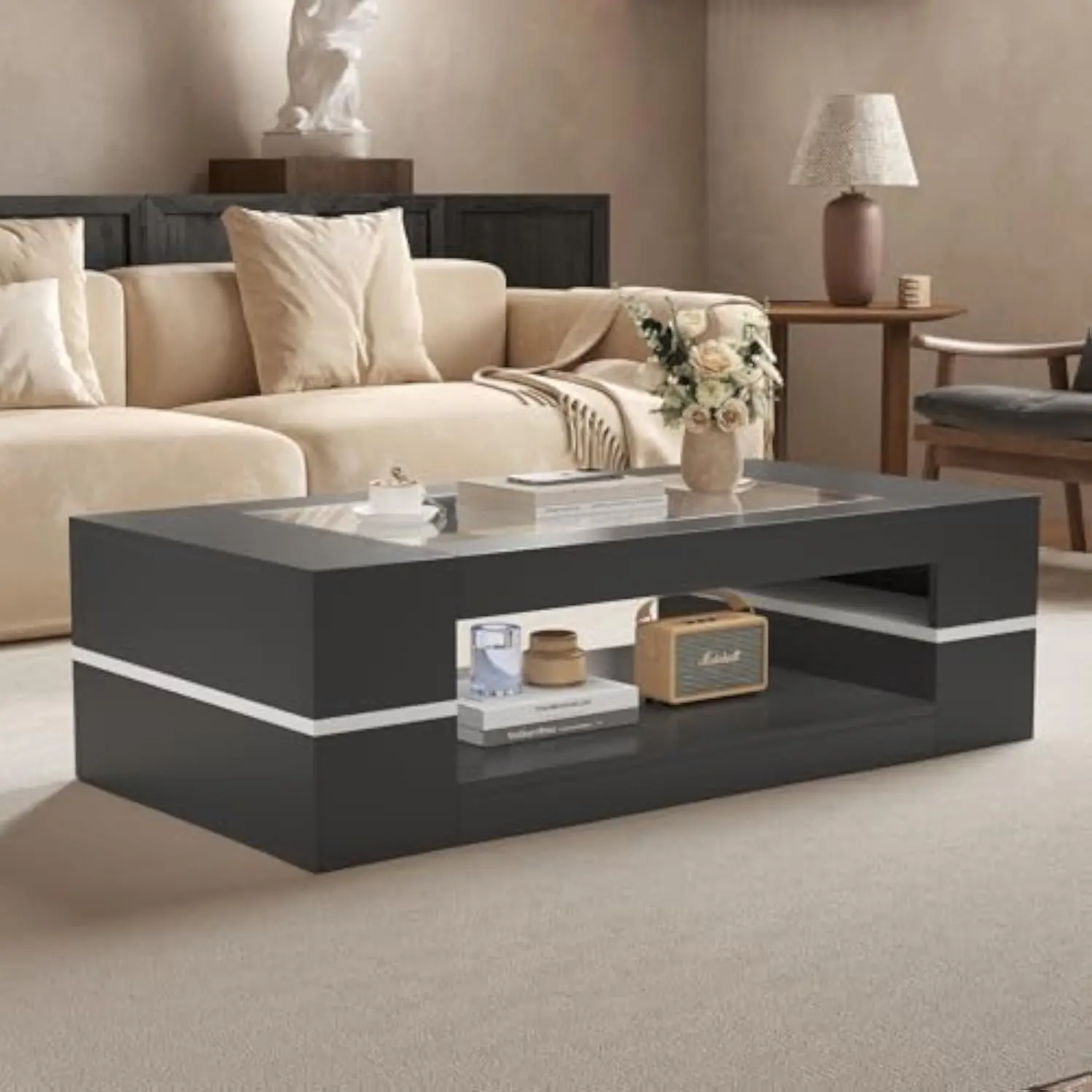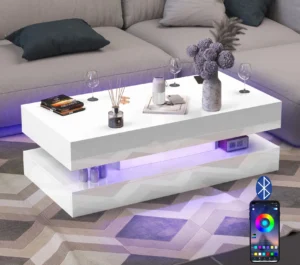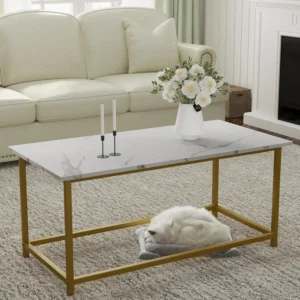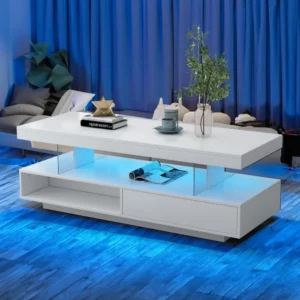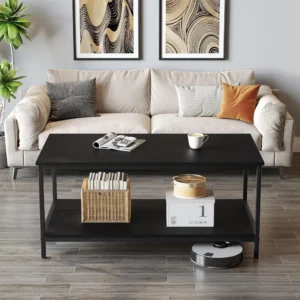Understanding the Strategic Impact of Rectangular Coffee Tables on Room Design
The coffee table might seem like just another piece of furniture, but it plays a crucial role in defining your living space. As the centerpiece of most seating arrangements, a coffee table does more than provide a place for your drinks and books – it shapes how people move through and experience your room.
Rectangular coffee tables, in particular, have a profound influence on:
- Traffic flow around your seating area
- Visual balance between furniture pieces
- How spacious or intimate your room feels
- The functionality and usability of your living area
When chosen thoughtfully, a rectangular coffee table can transform an awkward room into a well-organized, harmonious space. Understanding the essential information about rectangular coffee table design principles helps you make more informed decisions that enhance your entire room layout.
This guide will walk you through everything you need to know about using rectangular coffee tables to their full potential – from their unique design qualities to placement strategies and styling techniques that professional designers use.
The Innate Qualities of Rectangular Coffee Tables That Shape Your Space
Linear Structure and Visual Direction
Rectangular coffee tables naturally create strong horizontal lines that guide the eye and establish order in a room. This linearity isn’t just visually pleasing – it helps organize your space by creating invisible but powerful lines that define areas within your room.
Anchoring Effect
One of the most valuable design traits of rectangular coffee tables is their ability to ground a seating arrangement. Like the foundation of a building, they provide stability and a central focus that helps other furniture pieces make visual sense together.
Practical Proportions
The elongated shape of rectangular tables offers practical advantages for everyday use. Their proportions typically provide more usable surface area than other shapes, allowing space for both decorative items and functional needs like drinks, books, or remote controls.
Space Definition
Rectangular tables excel at defining zones within open spaces. Their clear boundaries help separate conversation areas from walkways, creating a natural structure that makes even large, open rooms feel organized and intentional.
Exploring mid-century modern rectangular coffee tables reveals how these qualities have made this shape an enduring favorite among designers who understand the importance of both form and function.
Positive Ways Rectangular Coffee Tables Enhance Room Layout
Creating Harmony in Open Concepts
In today’s popular open floor plans, rectangular coffee tables help define living areas without walls. Their strong geometric presence establishes boundaries that tell people “this is the living area” without cutting off sight lines or conversation flow.
Anchoring Seating Arrangements
Rectangular coffee tables provide a natural center for your seating arrangement, giving sofas and chairs something to “gather around.” This anchoring effect makes furniture groupings feel purposeful and complete rather than scattered.
Optimizing Traffic Flow
When positioned correctly, a rectangular table creates predictable pathways around your seating area. Unlike round tables, which can create meandering paths, rectangular tables establish clear, efficient routes that help people navigate your space naturally.
Complementing Room Dimensions
In rectangular rooms (the most common room shape), a rectangular coffee table creates pleasing parallel lines that enhance the natural architecture. This is especially helpful in:
- Narrow living rooms where the table’s shape reinforces the room’s direction
- Long spaces where the table helps maintain proportion
- Open concept areas where the table helps define the living space
Perfect Pairing with Standard Sofas
Most sofas feature straight lines and rectangular proportions. A rectangular coffee table creates a natural visual companion that respects and enhances these lines. The design principle suggests that ideally, your coffee table should be about two-thirds the length of your sofa for optimal visual balance.
Expert guidance on space planning with rectangular tables can help you leverage these benefits in your specific room configuration, creating a space that feels both beautiful and functional.
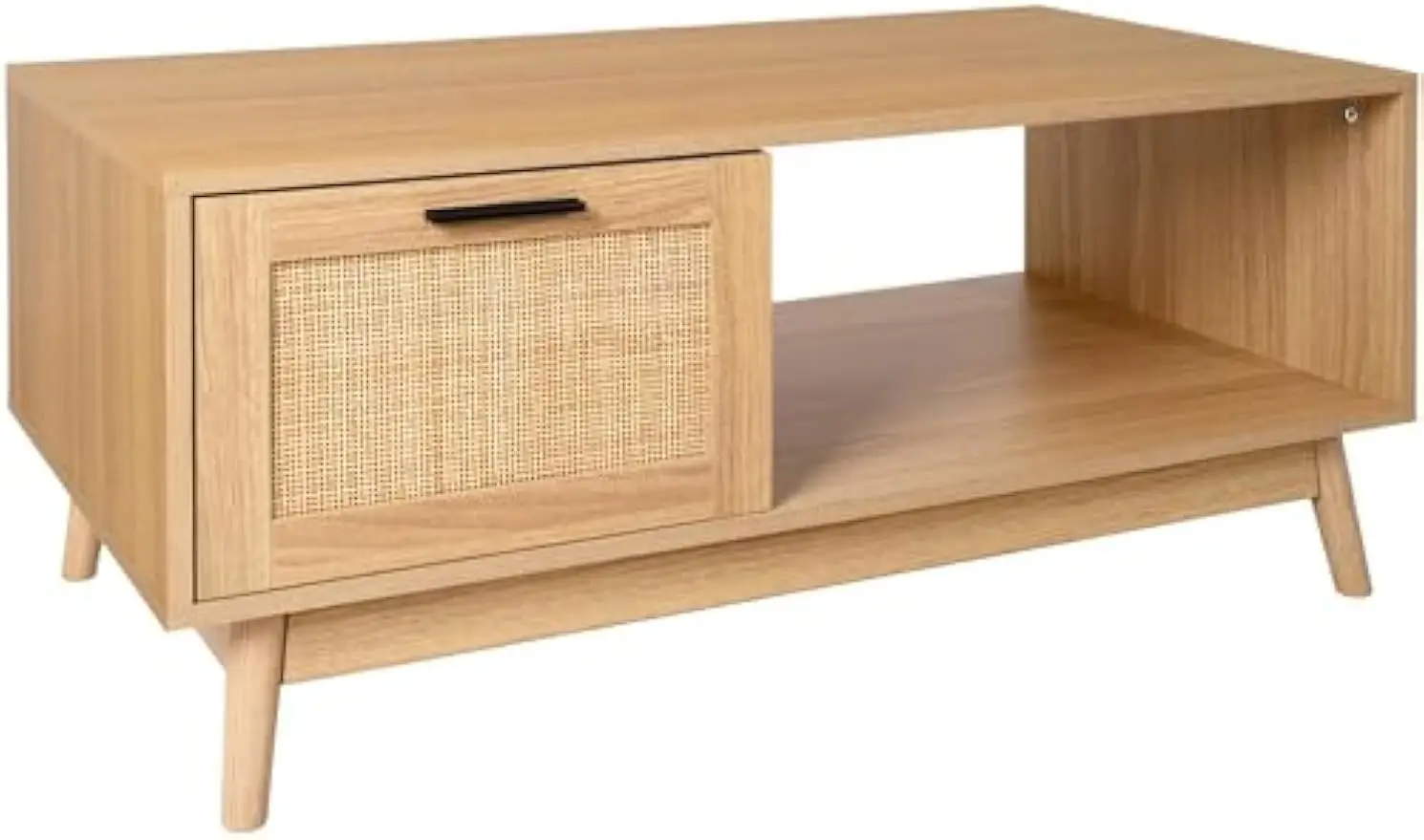
Potential Challenges of Rectangular Coffee Tables and Smart Solutions
Traffic Flow Constraints
In smaller rooms, a rectangular coffee table might restrict movement if not properly sized. The corners can create pinch points that make navigating the space uncomfortable.
Solution: Choose a smaller table or consider a narrow rectangular design that preserves pathways around your seating area.
Safety Concerns with Sharp Corners
The defined corners of rectangular tables can be hazardous in homes with young children or in high-traffic areas.
Solution: Look for tables with rounded corners, add corner guards, or consider a rectangular table with a completely rounded edge profile.
Visual Weight in Compact Spaces
Solid rectangular tables can sometimes feel heavy or dominating in smaller rooms, making the space feel cramped.
Solution: Glass top options create visual lightness while maintaining the rectangular shape. Tables with slim legs or open bases also reduce visual weight.
Compatibility with Curved Furniture
When paired with curved or round seating, rectangular tables can sometimes create an awkward visual contrast.
Solution: Choose a rectangular table with softened corners or rounded edges, or consider how rectangular vs. square coffee tables might work differently with your specific furniture arrangement.
Strategic Placement: Mastering Room Layout with Your Rectangular Coffee Table
The position of your coffee table is just as important as its shape. Follow these guidelines to create a layout that balances beauty and functionality:
Essential Spacing Guidelines
- Leave 12-18 inches between the coffee table and seating to allow comfortable leg room
- Maintain at least 30 inches between the table and other furniture pieces to create comfortable walkways
- In dining areas, allow 36 inches minimum for chairs to pull out and people to circulate
Alignment Principles
Center your rectangular coffee table with your primary sofa for a balanced, orderly appearance. With L-shaped sectionals, align the table with the central axis of the seating arrangement rather than trying to fill the entire L-shape.
Adapting to Room Shapes
- Narrow rooms: Position the table with its length parallel to the long walls to reinforce the room’s natural lines
- Square rooms: Use the rectangular table to create direction and flow
- Open concept spaces: Place the table to help define the boundaries of your seating area
Understanding styling secrets for rectangular mid-century tables can help you refine these placement strategies for your specific space and style preferences.
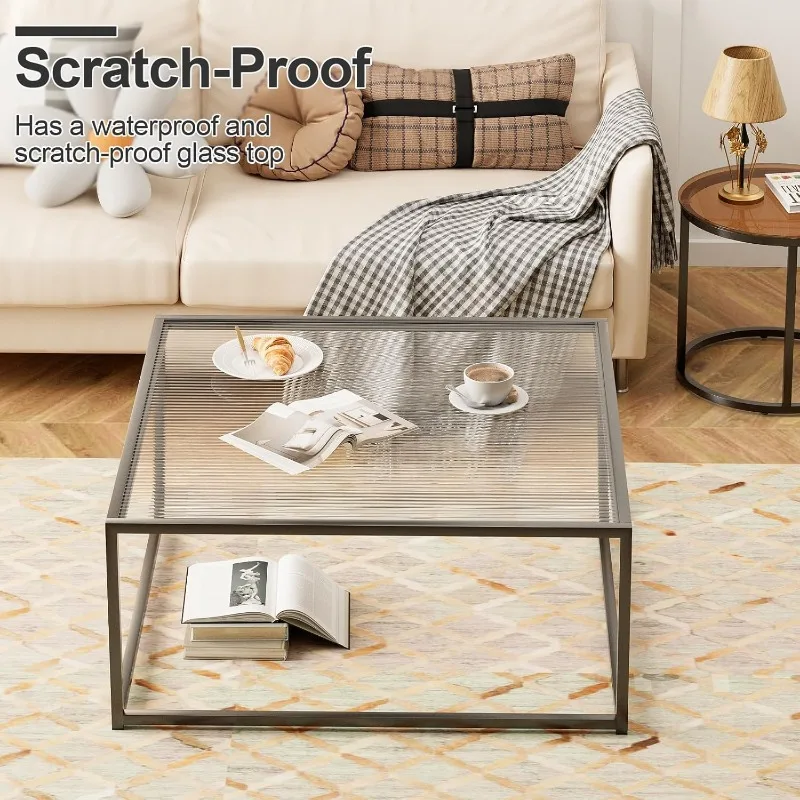
Choosing the Perfect Rectangular Coffee Table for Your Layout
Dimension Considerations
- Height: Ideally 1-2 inches lower than your sofa seat height (typically 16-18 inches)
- Length: Approximately two-thirds the length of your primary sofa
- Width: Typically between 22-30 inches to allow comfortable reach from all sides
Material Impact on Spatial Perception
- Glass: Creates visual lightness and makes small spaces feel larger
- Wood: Adds warmth and substance; darker woods create grounding while lighter woods feel airier
- Metal: Provides structure with minimal visual weight
- Stone: Adds substantial presence and natural texture
Base Style Influences
- Solid bases: Create a heavier, more substantial feel
- Legs at corners only: Maximize open space underneath, creating airiness
- Pedestal styles: Offer compromise between stability and openness
For larger rooms, large coffee tables provide substantial presence, while compact options work better in cozier settings. The key is proportional balance with your other furniture.
Mid-Century Modern Glass Top Coffee Tables, Mid-Century Modern Glass Top Side & End Tables
$460.58 Select options This product has multiple variants. The options may be chosen on the product pageMid-Century Modern Glass Top Coffee Tables, Mid-Century Modern Vintage Coffee Tables, Mid-Century Modern Vintage Side & End Tables
$725.36 Select options This product has multiple variants. The options may be chosen on the product pageMid-Century Modern Large Coffee Tables, Mid-Century Modern Rectangular Coffee Tables
$603.26 Select options This product has multiple variants. The options may be chosen on the product pageMid-Century Modern Marble Top Coffee Tables, Mid-Century Modern Rectangular Coffee Tables, Mid-Century Modern White Coffee Tables
Price range: $163.28 through $189.22 Select options This product has multiple variants. The options may be chosen on the product pageMid-Century Modern Rectangular Coffee Tables, Mid-Century Modern White Coffee Tables
$605.68 Select options This product has multiple variants. The options may be chosen on the product pageMid-Century Modern Black Coffee Tables, Mid-Century Modern Rectangular Coffee Tables
$272.43 Select options This product has multiple variants. The options may be chosen on the product page
Designer Techniques: Elevating Your Space with a Rectangular Coffee Table
Professional designers understand that a coffee table is more than functional furniture—it’s an opportunity to enhance your entire living space. Try these designer-approved techniques:
Define Zones with Rugs
Place your rectangular coffee table on a rug that extends 18-24 inches beyond the table on all sides. This creates a visual “zone” that unifies your seating arrangement and adds texture to your space.
Break Up the Rectangle
Avoid a flat, uninspiring surface by creating thoughtful arrangements on your table:
- Use the rule of thirds to divide the surface into visually interesting sections
- Create height variation with stacked books, plants, or decorative objects
- Include circular items to soften the rectangular lines
Creative Positioning
While centered placement is traditional, consider these designer alternatives:
- Offset the table slightly to create dynamic tension
- Pair with nesting side tables that can pull out when needed
- Use two identical rectangular tables side by side for flexible arrangement
Exploring additional comprehensive styling guide for rectangular coffee tables can help you perfect these techniques for your specific space.
Comparative Analysis: Rectangular vs. Other Coffee Table Shapes
Understanding how different table shapes affect your space helps confirm whether rectangular is truly the best choice for your room:
| Table Shape | Traffic Flow Impact | Best Room Match | Visual Effect |
|---|---|---|---|
| Rectangular | Creates defined pathways | Rectangular rooms, larger spaces | Organized, structured |
| Round | Allows fluid movement around edges | Small spaces, rooms with children | Soft, inviting |
| Square | Creates balanced, structured flow | Square rooms, formal spaces | Stable, grounded |
| Oval | Combines rectangular function with softer edges | Transitional spaces | Balanced compromise |
Rectangular tables generally excel in rooms with clear directional flow and where you want to establish distinct conversation areas. However, understanding the differences between round vs. rectangle coffee tables and oval vs. rectangular coffee tables can help you make the most informed choice for your specific needs.
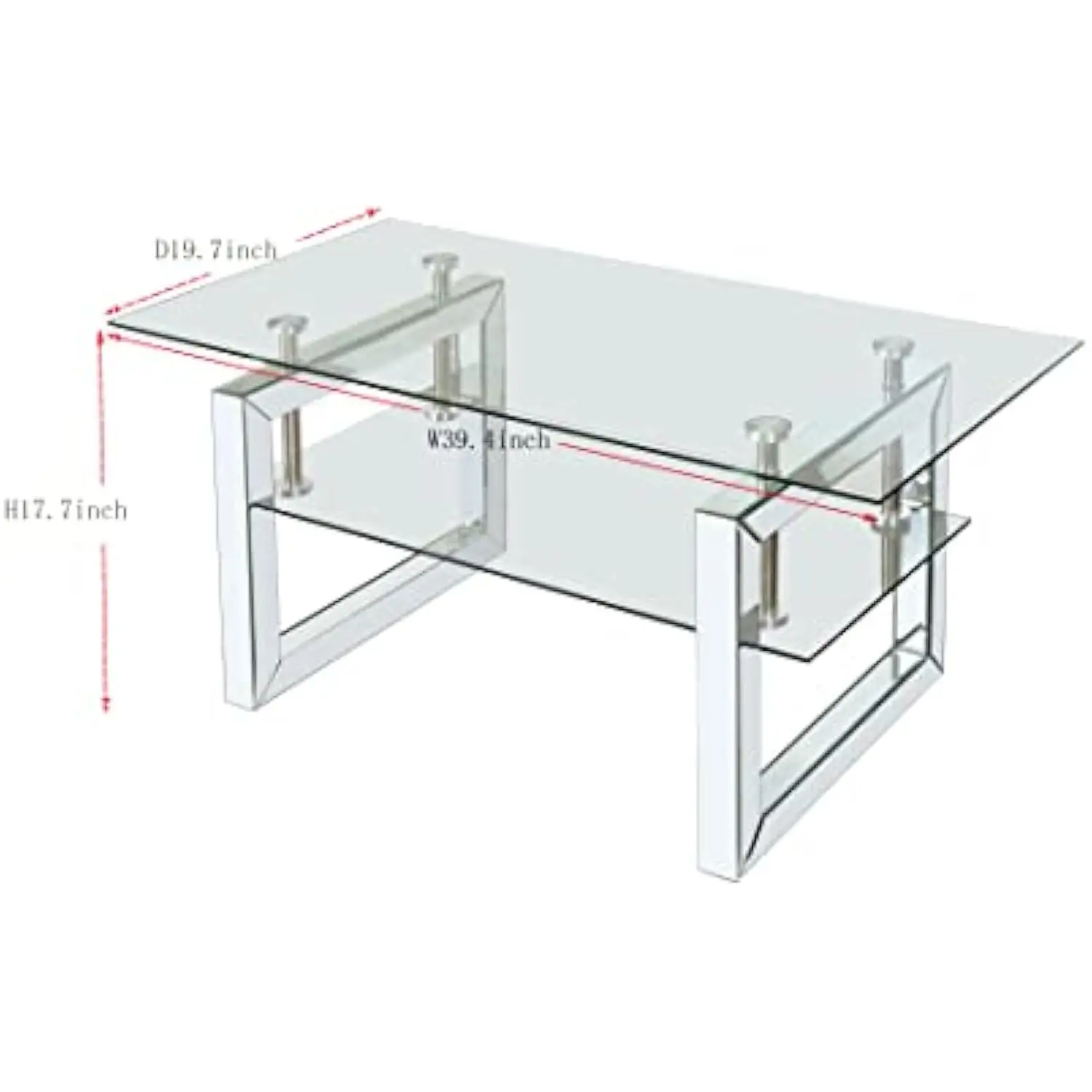
Frequently Asked Questions About Rectangular Coffee Tables and Room Layout
Can I use a rectangular coffee table in a small living room?
Yes, but choose a slim profile model and ensure you maintain at least 30 inches for walkways. Glass tops and open bases help reduce visual weight in compact spaces. Nesting tables offer another flexible solution for smaller rooms.
What’s the ideal distance between a rectangular coffee table and a TV stand or fireplace?
Maintain at least 30 inches between your coffee table and TV stand or fireplace to allow comfortable passage. This distance also creates proper visual breathing room between furniture pieces.
Do rectangular coffee tables work with curved or circular sofas?
While they can create an interesting contrast, the angular nature of rectangular tables sometimes clashes with very curved seating. Consider tables with rounded corners or softened edges to bridge this style gap.
How can I soften the look of a large rectangular coffee table that dominates my room?
Use styling elements like rounded decorative objects, plants with soft foliage, or textured items like woven baskets to balance the geometric rigidity. A table with rounded corners or a glass top can also help lighten its visual impact.
By thoughtfully selecting and placing your rectangular coffee table, you can transform your living space into a well-balanced, functional area that enhances both the beauty and usability of your home. At Hearth Forms, we believe the right coffee table isn’t just furniture—it’s the foundation of a well-designed living space.

